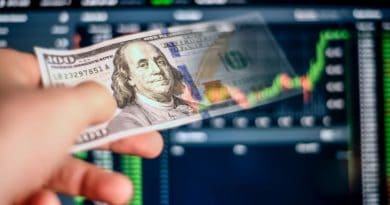[ad_1]
We are literally witnessing history in the making. For the third time in the last six trading sessions, we have witnessed the largest single day point crash in stock market history. Let that sink in for a moment. On March 9th, the Dow set a new record by falling 2,013 points. Then on March 12th, the Dow set a new record again by falling 2,352 points. Of course what happened on Monday was the biggest whopper of them all. The Dow Jones Industrial Average was down 2,997 points, and words like “carnage” and “devastation” don’t seem to be strong enough to convey that horror that took place. To put all of this into perspective, the largest single day point crash during the last financial crisis was just 777 points. That means that the crash that we witnessed on Monday was nearly four times as large as the worst single day point crash in 2008.
Of course all of this volatility is being driven by fear of the coronavirus. Even though less than 100 Americans have died so far, investors are completely freaking out.
So what will happen if thousands or even millions of us start dying?
On a percentage basis, the nightmare that we watched unfold on Monday was the worst day for stocks since “Black Monday” in 1987…
Stocks fell sharply Monday — with the Dow suffering its worst day since the “Black Monday” market crash in 1987 and its third-worst day ever — even after the Federal Reserve embarked on a massive monetary stimulus campaign to curb slower economic growth amid the coronavirus outbreak.
The Dow Jones Industrial Average closed 2,997.10 points lower, or 12.9%, at 20,188.52. The 30-stock Dow was briefly down more than 3,000 points in the final minutes of trading. The S&P 500 dropped 12% to 2,386.13 — hitting its lowest level since December 2018 — while the Nasdaq Composite closed 12.3% lower at 6,904.59 in its worst day ever.
Overall, the Dow is now down more than 31 percent from the all-time high set earlier this year.
If you can believe it, all of the tremendous stock market gains that we have witnessed over the last three years have been completely wiped out in just 18 trading days.
Ouch.
Banking stocks were hit particularly hard once again on Monday. Bank of America and JPMorgan Chase were each down more than 14 percent, Morgan Stanley was down more than 15 percent, and Citigroup was down more than 19 percent.
Remember, those are not figures for the entire year.
Those are figures for one day.
Of course the utter carnage was not just limited to stocks. The following is how Zero Hedge summarized some of the other losses that we witnessed…
- STOXX EUROPE 600 ENDS DOWN 4.9%, LOWEST CLOSE SINCE MID-2013
- SOUTH AFRICA’S FTSE/JSE INDEX FALLS AS MUCH AS 12.2%, MOST EVER
- MUNI BONDS EXTEND WORST ROUT SINCE 1987
- COPPER SLUMPS AS MUCH AS 5.2% AMID WEAKENING RISK APPETITE
- BRENT CRUDE OIL PLUNGES BELOW $30 FOR FIRST TIME SINCE 2016
- SILVER PLUNGES TO 2011 LOWS
- U.S. WHOLESALE GASOLINE PRICES PLUNGE 21%
- HYG WORST DROP SINCE 2008
- LQD WORST DROP SINCE 2008
The good news is that there is often a hefty rebound after a historic decline of this magnitude. It appears that stock prices will likely shoot back up a good bit on Tuesday, and that will temporarily soothe a lot of frazzled nerves.
But this coronavirus pandemic is not going away any time soon. Over the past couple of days, restaurants and bars have been shut down across the nation, schools have been shuttered for the foreseeable future, and it has been announced that the entire city of San Francisco will be locked down.
As virtually all forms of activity come to a standstill all over America, our economic numbers are going to absolutely collapse.
[ad_2]







